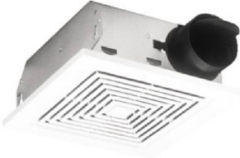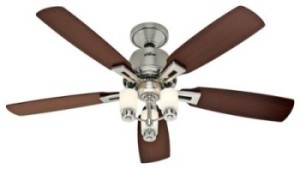Attic & Bathroom Ventilation

Bath fans help remove unwanted steam and moisture from leaving your bathroom. This can lead to mold and mildew, the leading cause of rot, structural damage, peeling paint and health problems. You can greatly reduce or eliminate the many problems created by excess moisture in your bathroom with the proper installation by a qualified electrician
An attic fan is an energy efficient way to keeping your home comfortable during the summer, and preventing ice dams during harsh winter months. Attic fans are intended to cool hot attics by drawing in cooler outside air from attic vents (soffit and gable), and pushing hot air to the outside. The electricians at Joule Electrical Contracting inspect your home to see if house can benefit by an attic fan, and provide the correct model that will fit your house!
Ceiling Fans

Ceiling fans can work wonders on warm summer evenings and even save you money in comparison to air conditioning units. Size, style and quality are all important considerations if you’re planning a ceiling fan purchase. If you’re thinking of placing a ceiling fan outside, make sure it’s designed to withstand the elements.
What style fan should you consider?
Ceiling fans are a fairly prominent element in a room, so you’ll want to settle on the right design. With several different styles available to choose from, find one that works best for your home. Choose a fan with a wood base for something more traditional, or consider one with a brushed steel finish for an updated, contemporary look.
How large should your fan be?
A fan needs to have enough room to rotate properly, and should be sized to match your room’s dimensions. To determine fan size, measure straight across from the blade tip to the opposite blade tip. Here is a general consensus of appropriate fan sizes in relation to square feet: a 32” fan for a room up to 80 square feet, a 42” fan for rooms between 80 and 120 square feet, a 44” fan for rooms between 120 and 144 square feet, and 52” and larger for rooms 144 square feet and over.
What types of construction details should you look for in your ceiling fan?
Keep in mind that the better the construction, the longer your fan will last you. Check that the blades and motor windings are the correct match; air circulates the most efficiently when these are in precise cohesion. To avoid a noisy, vibrating fan that works smoothly, look for double-shielded bearings with self-contained oil reservoirs. In addition, be sure the blades are sealed to prevent warping.
Should you purchase an energy efficient ceiling fan?
These tend to be more expensive off the bat, but will probably save you money over time. These fans are highly efficient, cutting down on your electric bill by maximizing the quality of air circulation. Look for an “Energy Star” sticker on the fan to ensure it’s energy efficient.
What do you need to consider in terms of installation?
This is largely dependent on the height and type of ceiling you have. In general, fans should be installed about eight feet from the ground, so if you have particularly high ceilings, you may need a downrod to bring it to the correct placement. Close or flush-mount installations are necessary for low ceilings, which are sometimes known as ceiling-hugger fans, while angle-mount will work for sloped ceilings.
What should you know if you’re looking for an outdoor ceiling fan?
Though they look similar to indoor fans, outdoor fans are internally designed to specifically resist moisture and are waterproof on the exterior. These features tend to make them slightly pricier.
What options do you have for controlling the fan?
Traditionally, pull cords have controlled all ceiling fans. This option is still available, but now you can also choose from wall controls or even remotes for further convenience. These can be programmed to determine specific fan speeds and control any light fixtures that may be attached to the fan.
What fan accessories might you like to add?
Kill two birds with one stone by wiring your ceiling fan for lighting. Easily control both the lighting and the fan speed with wall controls or a remote. Certain fans are also able to speed up or slow down according to the room’s temperature, ensuring your interior is always receiving the correct circulation.
reference